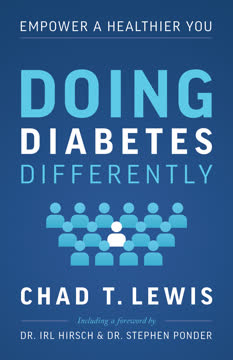Key Takeaways
1. Challenge the Status Quo: The Flawed Hierarchy of Diabetes Care
The system is ready and willing to commit you to a life of taking drugs and injectable insulin for diabetes, dealing with the eventual heart disease, kidney failure, and peripheral neuropathy with more drugs and procedures, providing “education” designed by people who put commercial interests first, while no one provides the handful of inexpensive health strategies that have been shown to reduce, even fully reverse, type 2 diabetes.
A critical look. The current diabetes care hierarchy prioritizes drugs and devices, often neglecting the foundational role of lifestyle. Medical education dedicates minimal time to nutrition and exercise, leading to a system focused on symptom management rather than root causes. This approach, while offering "medical miracles," often leaves patients frustrated and unwell.
The "scourge" of diabetes. Diabetes is a metabolic disorder where the body mishandles macronutrients, especially carbohydrates, leading to high blood sugar. This can result in severe complications like blindness, impotence, neuropathy, kidney disease, heart attack, and stroke. Despite its devastating impact—affecting nearly one-third of adult Americans—the diabetes epidemic lacks the urgency seen in other public health crises.
A costly crisis. The financial burden of diabetes is staggering, costing the U.S. $327 billion in 2017, representing 25% of all healthcare costs. This figure is projected to grow, yet public policy and research funding disproportionately favor treatment over prevention and cure. This book argues for a shift in focus, empowering individuals to take charge of their health by prioritizing mental fortitude, nutrition, and exercise.
2. Embrace Your "Abnormal" Metabolism: The Mental Shift
Normal eating isn’t in the cards for those of us with diabetes, despite what some experts may have us believe.
Shatter the normalcy myth. A crucial first step is accepting that your metabolism is not "normal" and you cannot eat like everyone else. The pervasive idea that modern drugs and devices can simply "cover" any diet, including sugary treats and fast food, is a dangerous fallacy. This misconception leads to a glycemic roller coaster, frustration, and ultimately, poor health outcomes.
The "sugar myth" debunked. Many experts claim that sugar is not "forbidden" for people with diabetes, as long as it's "accounted for." This is akin to telling an alcoholic they can drink in moderation. Sugar, especially added sucrose and high-fructose corn syrup, is highly seductive and potentially addictive, making moderation incredibly difficult for a compromised metabolism.
- Average American consumes 66 pounds of added sugar annually.
- Sugar's addictiveness is comparable to cocaine in some studies.
- Combining sugar with fat (the "deadly duo") amplifies negative effects.
Reframe your motivation. Victor Vroom's Expectancy Theory highlights that motivation is low if you don't believe your efforts will lead to success. Trying to "balance" medication with a high-carb, "normal" diet is overwhelming and demotivating due to the 41+ factors affecting blood sugar. Simplifying your diet to reduce carbs and avoid sugar can dramatically increase your belief in your ability to manage diabetes effectively.
3. Beyond Dieting: A Permanent Lifestyle, Not a Temporary Fix
What you eat when you’re losing weight will be essentially what you eat as you’re maintaining your weight over the long term.
The futility of temporary diets. "Going on a diet" implies a temporary state, often leading to a cycle of weight loss and regain (yo-yo dieting). Commercial diet programs, with their packaged foods and "phasing back" of forbidden items, reinforce this unsustainable mindset. Studies show a high failure rate for diets, with one "Biggest Loser" follow-up revealing a 93.8% failure rate after six years.
Weight loss as a byproduct. Instead of dieting to lose weight, focus on adopting a permanent, healthy eating pattern that safely maintains healthy blood sugars with minimal medication. If weight loss is needed, it will naturally occur as a byproduct of this lifestyle change. This approach addresses the root cause (unhealthy metabolism) rather than just the symptom (excess weight).
- Less insulin is needed, which is the fat-storage hormone.
- Lower insulin levels naturally lead to weight loss for most overweight individuals.
- This shift promotes stable weight maintenance at a healthy set point.
The "set point" dilemma. Our bodies resist significant, rapid weight changes, often slowing metabolism to maintain a "set point." Sustainable weight management comes from consistent, long-term habits, not crash diets. The National Weight Control Registry, tracking successful maintainers, found they consistently:
- Cut calories (often by reducing overall food intake).
- Self-monitored (regular weighing, blood sugar checks).
- Exercised regularly (for maintenance, not primary loss).
- Ate a less-varied diet and avoided bingeing.
4. Adopt a Twelve-Step Mindset: One Day at a Time
Today, I will eat healthy food and only healthy food. I will engage in at least a modicum of healthy exercise. Tomorrow, the same. One day at a time.
Diabetes and alcoholism: striking parallels. Poorly controlled diabetes shares many characteristics with alcoholism, including daily chaos, negative impact on family, "policing" behavior, unhealthy consumption of pleasurable substances, guilt, and progressive health decline. Acknowledging this seriousness, much like an alcoholic admitting their condition, is a powerful step towards recovery.
The power of "one day at a time." A twelve-step perspective, adapted from Alcoholics Anonymous, offers a framework for daily commitment. It's about abstaining from unhealthy eating and exercise habits today, and repeating that commitment tomorrow. This mindset shifts focus from overwhelming long-term goals to manageable daily actions, fostering consistency and resilience.
- Define a healthy program: Establish clear diet and exercise routines.
- Be in the present: Focus on today's choices.
- Commit daily: Practice disciplined adherence.
- Live with purpose: Find meaning beyond just managing the disease.
- Seek support: Connect with others on a similar journey.
- Collaborate with care providers: Stage medication adjustments.
Beyond abstinence: spirituality and support. A twelve-step approach isn't just about deprivation; it includes a "spiritual component" – an active relationship with a purpose greater than oneself. This could be a higher power, loved ones, or a meaningful cause, providing motivation beyond mere self-control. Support from fellow travelers, whether through formal groups or informal connections, is also vital for sustained success.
5. Balance Macronutrients: Low-Carb, High-Fat for Most
Food is the key!!!
The macronutrient teeter-totter. For people with diabetes, achieving healthy blood sugars with minimal medication hinges on balancing macronutrients: carbohydrates, fats, and protein. The "deadly duo" of high-carb, high-fat eating (the Standard American Diet, or SAD) is particularly detrimental, leading to insulin resistance, weight gain, and prolonged blood sugar spikes.
- High-carb, high-fat: SAD, leads to insulin resistance, metabolic syndrome.
- Low-carb, high-fat: Works for all, minimizes insulin, promotes fat burning.
- High-carb, low-fat: Exception for some, plant-based, reduces insulin resistance.
Low-carb, high-fat: the universal plank. This approach effectively manages diabetes for most, promoting stable blood sugars and reduced medication needs. It can be ketogenic (very low carb, burning fat for fuel) or moderately low-carb (100-125g/day). Don't fear healthy fats; historical examples like the Inuit and modern success stories like Dr. Bernstein demonstrate its efficacy.
- Ketogenic diet: <50-70g carbs/day, produces ketones for energy.
- Moderate low-carb: ~100-125g carbs/day, still low insulin demand.
- Safety first: Consult your doctor, especially if insulin-dependent or with kidney issues.
The high-carb, low-fat exception. A plant-based, high-carb, very low-fat diet (like the rural Asian diet) can work for a minority, particularly active individuals with Type 2 diabetes who retain pancreatic function, or exceptionally well-managed Type 1s. This diet reduces fat intake to below 30g/day, making insulin highly efficient. However, for most overweight or insulin-resistant individuals, the low-carb plank is more effective at reducing insulin levels and fat storage.
6. Fear No Fat, Shun All Added Sugar: The Rules of Healthy Eating
What you eat is as important, if not more so, as how much you eat, as measured by calories.
Beyond calorie counting. While calories matter for energy balance, their quality is paramount. High-quality calories promote satiety, are less likely to be stored as fat, and are nutritionally dense. Focusing on the nature of food rather than just the quantity, as measured by calories, is a more effective strategy for long-term health and blood sugar management.
Dietary fat is healthy. The demonization of dietary fat, especially saturated fat, since the 1970s, has been largely refuted by modern research. Saturated fat is not directly linked to cardiovascular disease or Type 2 diabetes, and dietary cholesterol is essential. Instead, focus on avoiding harmful trans fats (partially hydrogenated oils) and choosing healthy fats like olive or coconut oil.
- Saturated fat: Not associated with all-cause mortality or CVD.
- LDL cholesterol: High levels alone are not always predictive of heart attack; particle type matters (NMR LipoProfile).
- Trans fats: Indisputably harmful, banned by FDA, check labels for "partially hydrogenated oil."
The six rules of healthy diabetic eating: These guidelines apply regardless of your chosen macronutrient plank, emphasizing whole, unprocessed foods and strict avoidance of added sugars.
- Embrace healthy fats: No fear of fat or cholesterol; avoid trans fats; use olive/coconut oil.
- Prioritize non-starchy vegetables: For low-carb, focus on cruciferous and above-ground veggies; limit starchy ones and fruit.
- For high-carb (minority): Emphasize whole-grain versions of rice, pasta, bread sparingly; focus on "good" vegetables, beans, lentils.
- Absolutely no forbidden foods: No fruit juice, added sugars, processed sweets, sugary cereals, or sodas (except for hypoglycemia treatment).
- Eat real food: Shop the grocery store perimeter (vegetables, fish, meat, poultry, eggs); avoid processed, packaged foods; no fast food.
- Consistency over variety: Eat a less-varied diet, avoid bingeing, and stick to it daily, even on holidays.
7. Exercise for Health, Not Weight Loss: Make it a Non-Negotiable Chore
One won’t effectively offset the other.
Exercise is not a weight-loss tool. Trying to lose weight solely through exercise is often futile. The caloric deficit math is challenging (e.g., a 30-minute run burns calories equivalent to one jelly donut), and exercise alone rarely leads to significant, sustained weight loss. Nutrition and exercise are two sides of the same coin; both are essential for metabolic homeostasis, and one cannot effectively compensate for the other.
The overwhelming benefits of movement. Despite its limited role in primary weight loss, exercise offers profound health benefits for people with diabetes:
- Reduced risk: Heart disease, stroke, Type 2 diabetes, high blood pressure, dementia, cancer.
- Improved sleep: Better insomnia and sleep apnea.
- Enhanced cognition: Memory, attention, processing speed.
- Better balance and bone health.
- Reduced depression and anxiety.
- Lower A1c values and insulin resistance.
Rethink your approach to exercise. Forget the idea that exercise must be "fun" to be sustainable. Treat it as a necessary chore, like brushing your teeth or mowing the lawn. This shifts expectation from enjoyment to accomplishment, increasing adherence.
- No gym required: Bodyweight exercises, dumbbells, or simple walking are effective.
- Small efforts count: Even a few minutes daily can significantly reduce mortality risk.
- Separate fun from health: Enjoy leisure activities (like golf) but ensure dedicated "exercise for health" sessions are met.
Safety and scheduling are paramount. Always consult your care provider to assess physical capacity and potential limitations due to diabetes complications. Exercise significantly impacts blood sugar, so careful planning is essential, especially for those on blood sugar-lowering medications.
- Hypoglycemia risk: Exercise can drop blood sugar; pre-exercise carbs or insulin adjustments may be needed.
- Hyperglycemia risk: Intense anaerobic exercise can sometimes raise blood sugar due to stress hormones.
- High blood sugar warning: Avoid exercise if blood sugar is >250 mg/dL with ketones present.
- Scheduling: Consider fasted exercise or exercising an hour after a meal to optimize blood sugar response.
8. Less is More: Minimize Reliance on Drugs and Devices
Safely managing blood sugars with the smallest amounts of medication significantly reduces these threats.
The proliferation of pharmaceuticals. The diabetes drug market has exploded, with over 240 medications and devices available, a 60% increase in just two years. This leads to polypharmacy (taking five or more medications daily), especially for Type 2 diabetes, creating bewildering treatment regimens and numerous potential side effects and interactions.
The hidden costs of "more." While drugs and devices can be life-saving, over-reliance on them carries significant drawbacks:
- Side effects: Every medication has potential adverse effects. Insulin, sulfonylureas, and meglitinides carry a dangerous risk of hypoglycemia, which can be life-threatening and contribute to cardiovascular events. Other drugs, like SGLT-2 inhibitors, have a range of side effects from kidney injury to infections.
- Interactions: Co-administered drugs, foods, or existing conditions can interact, altering effectiveness or increasing toxicity. Understanding these interactions (major, moderate, minor) is crucial.
- Financial burden: Diabetes-related medical expenses are 2.3 times higher than for non-diabetics. Escalating drug prices, particularly for insulin, have led to tragic rationing and deaths. Minimizing medication through lifestyle changes is the best way to save money and reduce reliance on a complex, costly supply chain.
Devices: a double-edged sword. Glucometers and Continuous Glucose Monitors (CGMs) are transformative, enabling dynamic blood sugar management. Insulin pumps offer convenience. However, the promise of a "closed-loop artificial pancreas" or stem-cell-derived islet cells, while miraculous, could paradoxically lead to poorer health if it encourages a return to unhealthy eating habits, leading to weight gain, insulin resistance, and other complications.
9. Master Dynamic Blood Sugar Management: Eat to the Meter or Sugar Surf
You can’t improve or manage what you can’t measure.
The power of measurement. Peter Drucker's adage perfectly applies to diabetes: glucometers and CGMs provide the data needed for dynamic management. This shifts diabetes care from a static, passive approach to an active, responsive one, allowing continuous improvement in blood sugar control.
"Eating to the meter" for all. This involves frequent blood sugar checks (before meals, two hours after, bedtime, overnight) and keeping a food log to understand how specific foods and activities impact your glucose levels. For Type 2 diabetics, this can mean adjusting meal choices or exercising after eating to blunt spikes. For insulin users, it means dynamically adjusting bolus and basal rates based on real-time data, moving beyond static ratios.
- Learn from experience: Identify foods to avoid and strategies to smooth glycemic spikes.
- Active management: Respond to readings by adjusting food intake or activity.
- Goal: Normalize A1c and reduce medication over time.
"Sugar Surfing" for insulin users. Developed by Dr. Stephen Ponder, Sugar Surfing takes dynamic management to the next level, utilizing CGM trend data (readings every five minutes) to continuously "ride the glycemic wave." Surfers anticipate trends, dose small "nudges" of insulin or carbs, and respond quickly to changes.
- Continuous data: CGM provides real-time insights into blood sugar direction and speed.
- Anticipatory action: Proactive adjustments prevent large highs and lows.
- Reduced variability: Smaller, more frequent adjustments lead to greater glycemic stability.
- Applicable to MDI: Works with multiple daily injections, not just pumps.
10. Integrate for Success: A Holistic, Continuously Improving System
All parts of a system need to work well together.
Empowering a healthier you. Optimal diabetes management is a holistic system where mental fortitude, nutrition, exercise, and judicious use of medication are interconnected and mutually reinforcing. Each component strengthens the others, leading to improved blood sugars, time in range, and insulin sensitivity. This continuous feedback loop, driven by monitoring data, allows for ongoing refinement and better health outcomes.
The importance of routine. A consistent daily routine is vital for integrating these components effectively. Eating similar foods at similar times, exercising regularly, and frequent blood glucose monitoring reduce unpredictability and foster discipline. This regularity helps stabilize blood sugars and minimizes the mental load of constant decision-making.
Addressing systemic challenges and individual caveats. While this framework empowers individuals, systemic issues remain. Food deserts, high costs of healthy food and medical supplies, and insurance limitations disproportionately affect the poor. This book is primarily for adults, as children and teenagers face unique challenges in adhering to strict dietary and lifestyle changes.
- Systemic barriers: Affordability, access to healthy food, cost of supplies.
- Children and teens: Require different approaches and strong family support.
- Care provider engagement: Seek out qualified providers willing to collaborate on this holistic approach.
A path to a healthier future. You don't have to accept diabetes as a progressive condition leading to early decline. By embracing an "abnormal" metabolism, adopting a disciplined lifestyle, and dynamically managing your blood sugars with minimal medication, it is possible to live a long, healthy, and fulfilling life. This book provides the roadmap; the journey is yours to take.
Last updated:
Review Summary
Doing Diabetes Differently receives mostly positive reviews, with readers appreciating its fresh approach to diabetes management. Many find the book informative, empowering, and practical, offering valuable insights for both diabetics and caregivers. Readers praise the author's emphasis on mindset, lifestyle changes, and personalized care. Some criticize the book for being dry or extreme in its recommendations. Overall, reviewers appreciate the comprehensive information, references to other resources, and the author's personal experience with diabetes.
Similar Books
Download PDF
Download EPUB
.epub digital book format is ideal for reading ebooks on phones, tablets, and e-readers.







